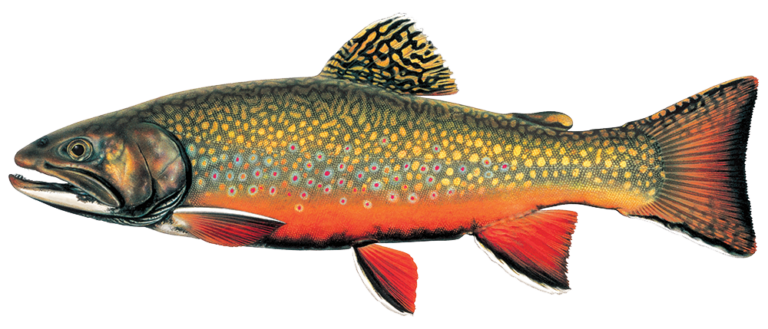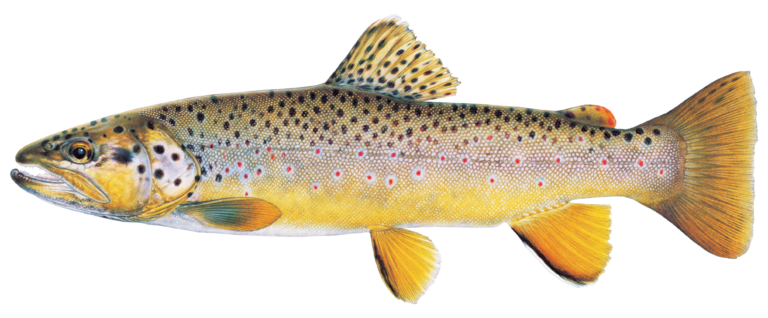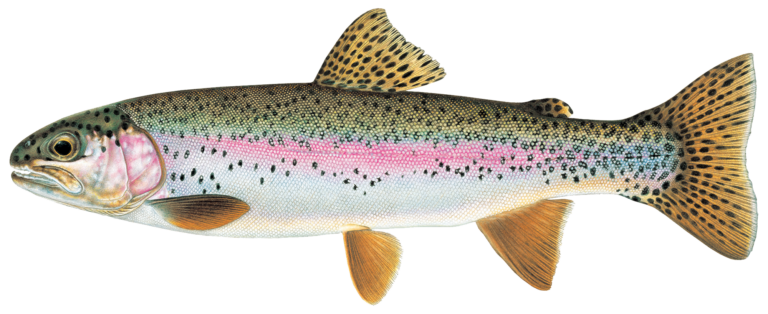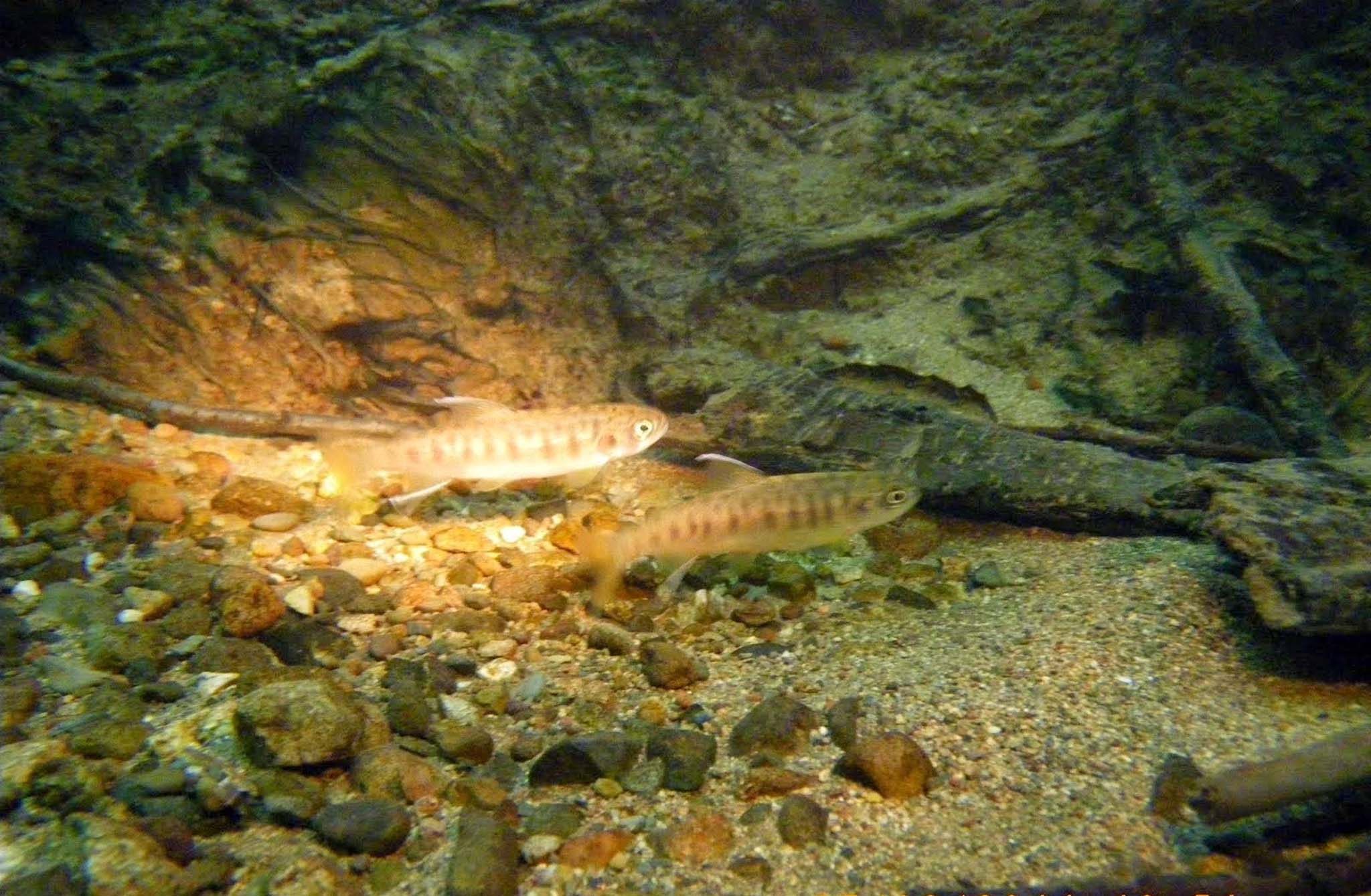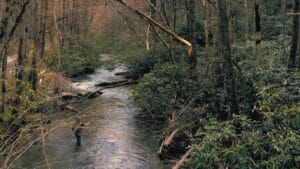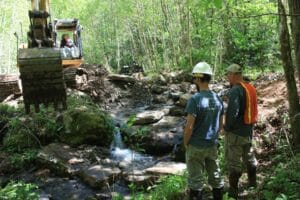North Carolina

Overview
Home to Mount Mitchell — the tallest peak in the East — North Carolina’s mountains have thousands of miles of trout streams. From the headwaters of the mighty New River on the state’s northern border to the Chattooga and Savannah headwaters in the far southwest, the state’s wild trout waters tend to share one key attribute: elevation. Rivers and creeks found at 2,500 feet and above generally feature the cold water that trout require, with maturing forests providing shaded riparian areas to help keep waters cool, a critical component of resiliency in the face of a warming climate. Improving connectivity and enhancing habitat is making these wild trout strongholds even better.
Threats & Opportunities
As with other states in the Southeast, North Carolina’s trout streams are vulnerable to warming global temperatures. However, because so many streams are at elevations of 2,500 feet and above, modeling has shown an encouraging degree of resilience to climate change. Abundant public land and funding create excellent opportunities for TU to work with key partners such as the Forest Service on projects that improve habitat and connectivity within brook trout strongholds throughout the state.
How We Work
Reconnection
We’re advocating for removing or improving fish passage at barriers large and small. Removing dams or perched culverts improves access to habitat for wild trout.
Restoration
We use a variety of tools, including the Eastern Brook Trout Conservation Portfolio, to prioritize streams where habitat restoration is most needed and where it will have the most impact and best chance for long-term success. Restoration efforts include stabilizing stream banks and improving riparian health by planting native trees. Trout Unlimited is also expanding strategic wood addition work, enhancing stream habitat, and reducing flood risks by adding large trees to streams.
Protection
We are engaging landowners to protect North Carolina’s coldwater trout streams by advocating for commonsense development, working with land trusts to protect key places, and setting up conservation easements. By working with state freshwater fisheries officials, we are in a better position to advocate for needed regulatory protections, including carefully managed development in both heavily populated areas along the Chattahoochee tailwater and tourist communities in the mountains.
How You Can Help
Help us assess barriers to fish passage and get your hands dirty with us on restoration projects
VOLUNTEERLearn about our work caring for and recovering Priority Waters in North Carolina and across the Southeast.
North Carolina Conservation Team

Amy Annino
Southern Appalachians Project Manager
amy.annino@tu.org
Southern Appalachians Project Manager
amy.annino@tu.org
Priority Waters

-
Northwest North Carolina
The rugged mountains around the popular mountain town of Boone feature the headwaters of famous stream systems, including the Yadkin, Watauga, Elk, and South Fork of the New. Brook trout thrive across the area. Wild trout are abundant, and efforts to reconnect habitat by addressing high-priority barriers are leading to more robust populations. Trout Unlimited is working extensively in the Wilson Creek watershed, an extremely popular recreation area.
-
Black Mountains
Ivy Creek and the Catawba River originate in the Black Mountains. With the highest peaks east of the Mississippi, this area is expected to remain resilient to climate change. Many of the systems’ tributaries offer excellent opportunities to target native brook trout, along with wild rainbows and browns.
-
Great Smoky Mountains National Park
No list of great wild trout fisheries in the East is complete without the Great Smoky Mountains National Park, which offers something for just about every kind of angler. The park offers blue-lining opportunities galore, with plenty of options deep in the backcountry. There are also some more accessible streams, like the popular and scenic Oconaluftee River near Cherokee.
-
Little Tennessee Headwaters
Beginning just below the North Carolina – Georgia state line south of Franklin and running to the North Carolina – Tennessee state line west of Robbinsville, the Little Tennessee watershed encompasses a number of key coldwater fisheries in the state. This part of North Carolina gives rise to waterways like the Cullasaja River, Nantahala River, and Santeetlah Creek. Peering down from the Cherohala Skyway, it’s easy to see why the high mountain streams of this area are refuges for numerous native brook trout populations.
-
Sky Island
Several key watersheds originate in this high-elevation region west of Hendersonville. The Mills and Tuckasegee rivers and tribs are popular trout fisheries, but the Davidson River is arguably this region’s star attraction — one that has benefited from TU protection and restoration work.
-
Chattooga / Savannah Headwaters
North Carolina shares this region with its neighbors, Georgia and South Carolina. The area includes stocked sections of the larger rivers but plenty of small mountain streams filled with eager native brook trout, along with wild rainbows and browns.

